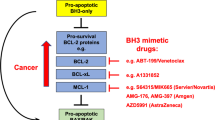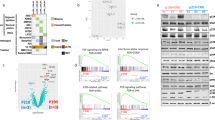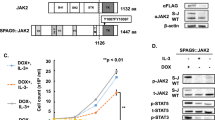Abstract
Pharmacological inactivation of cancer genes or products is being used as a strategy for therapy in oncology. To investigate the potential role of BCR-ABLp190 cessation in leukaemia development, we generated mice carrying a tetracycline-repressible BCR-ABLp190 transgene. These mice were morphologically normal at birth, and developed leukaemias. Disease was characterized by the presence of B-cell blasts co-expressing myeloid markers, reminiscent of the human counterpart. BCR-ABLp190 activation can initiate leukaemia in both young and adult mice. Transitory expression of BCR-ABLp190 is enough to develop leukaemia. Suppression of the BCR-ABLp190 transgene in leukaemic CombitTA-p190 mice did not rescue the malignant phenotype, indicating that BCR-ABLp190 is not required to maintain the disease in mice. Similar results were obtained by inactivation of BCR-ABLp190 with STI571 (Gleevec; Novartis, East Hanover, NJ, USA) in leukaemic CombitTA-p190 mice. However, gradual suppression of BCR-ABLp190 in leukaemic CombitTA-p190 mice identified a minimum level of BCR-ABLp190 expression necessary to revert the specific block in B-cell differentiation in the leukaemic cells. Overall, the findings indicate that BCR-ABLp190 appears to cause epigenetic and/or genetic changes in tumour-maintaining cells that render them insensitive to BCR-ABLp190 inactivation.
This is a preview of subscription content, access via your institution
Access options
Subscribe to this journal
Receive 50 print issues and online access
$259.00 per year
only $5.18 per issue
Buy this article
- Purchase on Springer Link
- Instant access to full article PDF
Prices may be subject to local taxes which are calculated during checkout






Similar content being viewed by others
References
Bhatia R, Holtz M, Niu N, Gray R, Snyder DS, Sawyers CL et al. (2003). Persistence of malignant hematopoietic progenitors in chronic myelogenous leukemia patients in complete cytogenetic remission following imatinib mesylate treatment. Blood 101: 4701–4707.
Chabner BA, Roberts Jr TG . (2005). Timeline: chemotherapy and the war on cancer. Nat Rev Cancer 5: 65–72.
Chan LC, Karhi KK, Rayter SI, Heisterkamp N, Eridani S, Powles R et al. (1987). A novel abl protein expressed in Philadelphia chromosome-positive acute lymphoblastic leukemia. Nature 325: 635.
Choo Y, Sánchez-García I, Klug A . (1994). In vivo repression by a site-specific DNA-binding protein designed against an oncogenic sequence. Nature 372: 642.
Chu S, Xu H, Shah NP, Snyder DS, Forman SJ, Sawyers CL et al. (2005). Detection of BCR-ABL kinase mutations in CD34+ cells from chronic myelogenous leukemia patients in complete cytogenetic remission on imatinib mesylate treatment. Blood 105: 2093–2098.
Clark SS, McLaughlin J, Crist WM, Champlin R, Witte ON . (1987). Unique forms of the abl tyrosine kinase distinguish Ph′-Positive CML from Ph′-positive ALL. Science 235: 85.
Cobaleda C, Gutierrez-Cianca N, Perez-Losada J, Flores T, Garcia-Sanz R, Gonzalez M et al. (2000). A primitive hematopoietic cell is the target for the leukemic transformation in human Philadelphia-positive acute lymphoblastic leukemia. Blood 95: 1007–1013.
Cobaleda C, Pérez-Losada J, Sánchez-García I . (1998). Chromosomal abnormalities and tumor development: from genes to therapeutic mechanisms. Bioessays 20: 922.
Copelan EA, McGuire EA . (1995). The biology and treatment of acute lymphoblastic leukemia in adults. Blood 85: 1151–1168.
Cox CV, Evely RS, Oakhill A, Pamphilon DH, Goulden NJ, Blair A . (2004). Characterization of acute lymphoblastic leukemia progenitor cells. Blood 104: 2919–2925.
Druker BJ, Sawyers CL, Kantarjian H, Resta DJ, Reese SF . (2001b). Activity of a specific inhibitor of the BCR-ABL tyrosine kinase in the blast crisis of chronic myeloid leukemia and acute lymphoblastic leukemia with the Philadelphia chromosome. N Engl J Med 344: 1038–1042.
Druker BJ, Talpaz M, Resta DJ, Peng B, Buchdunger E, Ford JM et al. (2001a). Efficacy and safety of a specific inhibitor of the BCR-ABL tyrosine kinase in chronic myeloid leukemia. N Engl J Med 344: 1031–1037.
Druker BJ, Tamura S, Buchdunger E, Ohno S, Segal GM, Fanning S et al. (1996). Effects of a selective inhibitor of the Abl tyrosine kinase on the growth of Bcr-Abl positive cells. Nat Med 2: 561–566.
Etzioni R, Ramsey S, McIntosh M, Schwartz S, Reid B, Radich J et al. (2003). The case for early detection. Nat Rev Cancer 3: 243–252.
Ford AM, Molgaard HV, Greaves MF, Gould HJ . (1983). Immunoglobulin gene organization and expression in hematopoietic stem cell leukemia. EMBO J 2: 997.
Garcia-Hernandez B, Castellanos A, Lopez A, Orfao A, Sanchez-Garcia I . (1997). Murine hematopoietic reconstitution after tagging and selection of retrovirally transduced bone marrow cells. Proc Natl Acad Sci USA 94: 13239–13244.
Graham SM, Jorgensen HG, Allan E, Pearson C, Alcorn MJ, Richmond L et al. (2002). Primitive, quiescent, Philadelphia-positive stem cells from patients with chronic myeloid leukemia are insensitive to STI571 in vitro. Blood 99: 319–325.
Griffiths SD, Healy LE, Ford AM, Bennett CA, Voncken JW, Heisterkamp N et al. (1992). Clonal characteristics of acute lymphoblastic cells derived from BCR/ABL p190 transgenic mice. Oncogene 7: 1391–1399.
Hardy RR, Carmack CE, Shinton SA, Kemp JD, Hayakawa K . (1991). Resolution and characterization of pro-B and pre–pro-B cell stages in normal mouse bone marrow. J Exp Med 173: 1213–1225.
Hermans A, Heisterkamp N, von Lindern M, van Baal S, Meijer D, van der Plas D et al. (1987). Unique fusion of bcr and c-abl genes in Philadelphia chromosome positive acute lymphoblastic leukemia. Cell 51: 33.
Huettner CS, Zhang P, Van Etten RA, Tenen DG . (2000). Reversibility of acute B-cell leukaemia induced by BCR-ABL1. Nat Genet 24: 57–60.
Jackson EL, Willis N, Mercer K, Bronson RT, Crowley D, Montoya R et al. (2001). Analysis of lung tumor initiation and progression using conditional expression of oncogenic K-ras. Genes Dev 15: 3243–3248.
Kurzrock R, Shtalrid M, Rommero P, Kloetzer WS, Talpas M, Trujillo JM et al. (1987). A novel c-abl protein product in Philadelphia-positive acute lymphoblastic leukaemia. Nature 325: 631.
le Coutre P, Mologni L, Cleris L, Marchesi E, Buchdunger E, Giardini R et al. (1999). In vivo eradication of human BCR/ABL-positive leukemia cells with an ABL kinase inhibitor. J Natl Cancer Inst 91: 163–168.
Mauro MJ, Druker BJ . (2001). STI571: targeting BCR-ABL as therapy for CML. Oncologist 6: 233–238.
Melo JV . (1996). The diversity of BCR-ABL fusion proteins and their relationship to leukemia phenotype. Blood 88: 2375–2384.
Meuwissen R, Linn SC, van der Valk M, Mooi WJ, Berns A . (2001). Mouse model for lung tumorigenesis through Cre/lox controlled sporadic activation of the K-Ras oncogene. Oncogene 20: 6551–6558.
O’Dwyer ME, Druker BJ . (2001). The role of the tyrosine kinase inhibitor STI571 in the treatment of cancer. Curr Cancer Drug Targets 1: 49–57.
Palacios R, Karasuyama H, Rolink A . (1987). Ly1+ POR-B lymphocyte clones: phenotype, growth requirements and differentiation in vitro and in vivo. EMBO J 6: 3687.
Palacios R, Steinmetz M . (1985). Il-3-dependent mouse clones that express B-220 surface antigen, contain Ig genes in germ-line configuration, and generate B lymphocytes in vivo. Cell 41: 727–734.
Perez-Caro M, Perez-Mancera PA, Voces F, Sanchez-Garcia I . (2005). Of Man in Mouse: modelling human cancer genotype-phenotype correlations in mice. Curr Genom 6: 81–88.
Perez-Mancera PA, Gonzalez-Herrero I, Perez-Caro M, Gutierrez-Cianca N, Flores T, Gutierrez-Adan A et al. (2005a). SLUG in cancer development. Oncogene 24: 3073–3082.
Perez-Mancera PA, Perez-Caro M, Gonzalez-Herrero I, Flores T, Orfao A, de Herreros AG et al. (2005b). Cancer development induced by graded expression of Snail in mice. Hum Mol Genet 14: 3449–3461.
Sanchez-Garcia I . (1997). Consequences of chromosomal abnormalities in tumor development. Annu Rev Genet 31: 429–453.
Sanchez-Garcia I, Grutz G . (1995). Tumorigenic activity of the BCR-ABL oncogenes is mediated by BCL2. Proc Natl Acad Sci USA 92: 5287–5291.
Savage DG, Antman KH . (2002). Imatinib mesylate – a new oral targeted therapy. N Engl J Med 346: 683–693.
Schultze N, Burki Y, Lang Y, Certa U, Bluethmann H . (1996). Efficient control of gene expression by single step integration of the tetracycline system in transgenic mice. Nat Biotechnol 14: 499–503.
Secker-Walker LM . (1991). Distribution of Philadelphia positive acute lymphoblastic leukemia: geographical heterogeneity or age related incidence? Genes Chromosomes Cancer 3: 320–321.
Shah NP, Nicoll JM, Nagar B, Gorre ME, Paquette RL, Kuriyan J et al. (2002). Multiple BCR-ABL kinase domain mutations confer polyclonal resistance to the tyrosine kinase inhibitor imatinib (STI571) in chronic phase and blast crisis chronic myeloid leukemia. Cancer Cell 2: 117–125.
Skorski T, Nieborowska-Skorska M, Nicolaides NC, Szczylik C, Iverssen P, Iozzo RV et al. (1994). Suppression of Philadelphia leukemia cell growth in mice by BCR-ABL antisense oligodeoxynucleotide. Proc Natl Acad Sci USA 91: 4504.
Szczylik C, Skorski T, Nicolaides NC, Mancella L, Malaguarnera L, Venturelli D et al. (1991). Selective inhibition of leukemia cell proliferation by BCR-ABL antisense oligodeoxynucleotides. Science 253: 562.
Tabernero MD, Bortoluci AM, Alaejos I, Lopez-Berges MC, Rasillo A, Garcia-Sanz R et al. (2001). Adult precursor B-ALL with BCR/ABL gene rearrangements displays a unique immunophenotype based on the pattern of CD10, CD34, CD13 and CD38 expression. Leukemia 15: 406–414.
Towatari M, Yanada M, Usui N, Takeuchi J, Sugiura I, Takeuchi M et al. (2004). Combination of intensive chemotherapy and imatinib can rapidly induce high-quality complete remission for a majority of patients with newly diagnosed BCR-ABL-positive acute lymphoblastic leukemia. Blood 104: 3507–3512.
Van Etten RA . (2001). Models of chronic myeloid leukemia. Curr Oncol Rep 3: 228–237.
Wendel HG, de Stanchina E, Cepero E, Ray S, Emig M, Fridman JS et al. (2006). Loss of p53 impedes the antileukemic response to BCR-ABL inhibition. Proc Natl Acad Sci USA 103: 7444–7449.
Williams RT, Roussel MF, Sherr CJ . (2006). Arf gene loss enhances oncogenicity and limits imatinib response in mouse models of Bcr-Abl-induced acute lymphoblastic leukemia. Proc Natl Acad Sci USA 103: 6688–6693.
Wolff NC, Ilaria Jr RL . (2001). Establishment of a murine model for therapy-treated chronic myelogenous leukemia using the tyrosine kinase inhibitor STI571. Blood 98: 2808–2816.
Zhao RCH, McIvor RS, Griffin JD, Verfaillie CM . (1997). Gene therapy for chronic myelogenous leukaemia (CML): a retroviral vector that renders hematopoietic progenitors methotrexate-resistant and CML progenitors functionally normal and nontumorigenic in vivo. Blood 90: 4687.
Acknowledgements
We thank all members of lab 13 at IBMCC for their helpful comments and constructive discussions on this project. Research in our group is supported partially by FEDER and by MEC (SAF2003-01103, and PETRI No. 95-0913.OP), Junta de Castilla y León (CSI03A05), FIS (PI050087, PI050116, G03/179 and G03/136), Fundación de Investigación MMA, Federación de Cajas de Ahorro Castilla y León (I Convocatoria de Ayudas para Proyectos de Investigación Biosanitaria con Células Madre) and CDTEAM project. MPC is a postdoctoral fellow supported by G03/136 and G03/179 networks. MSM research is supported by FIS grant no PI041271.
Author information
Authors and Affiliations
Corresponding author
Rights and permissions
About this article
Cite this article
Pérez-Caro, M., Gutierrez-Cianca, N., González-Herrero, I. et al. Sustained leukaemic phenotype after inactivation of BCR-ABLp190 in mice. Oncogene 26, 1702–1713 (2007). https://doi.org/10.1038/sj.onc.1209968
Received:
Revised:
Accepted:
Published:
Issue Date:
DOI: https://doi.org/10.1038/sj.onc.1209968
Keywords
This article is cited by
-
Cancer induction by restriction of oncogene expression to the stem cell compartment
The EMBO Journal (2009)



